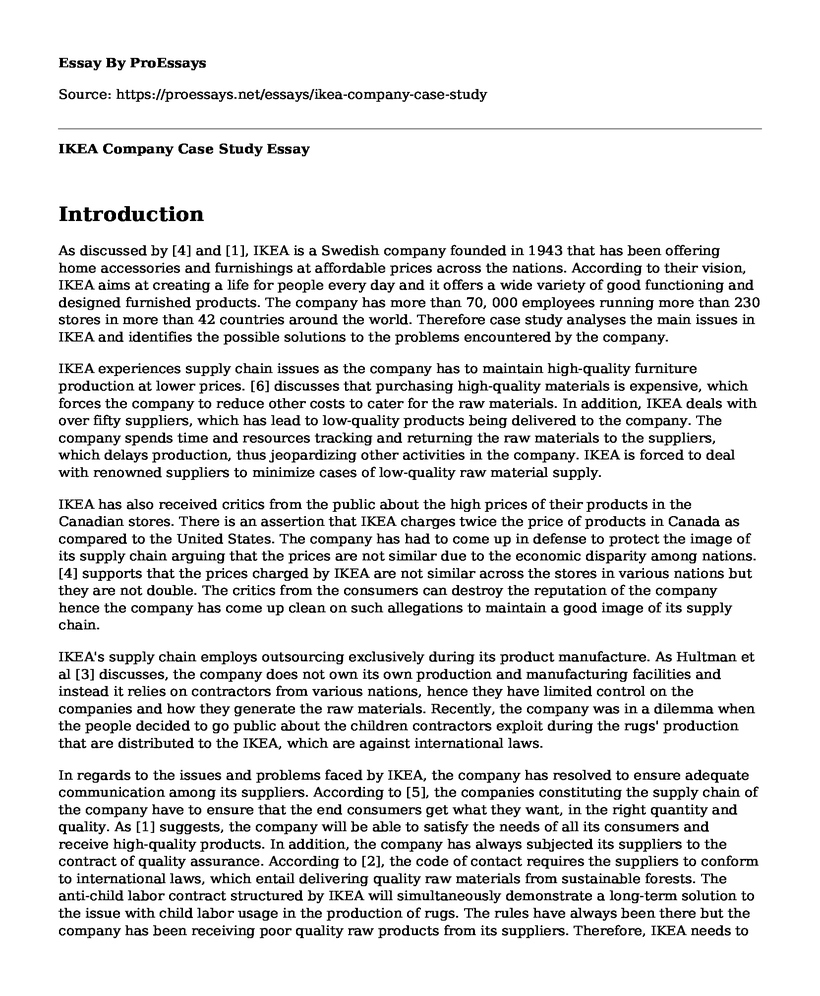Introduction
As discussed by [4] and [1], IKEA is a Swedish company founded in 1943 that has been offering home accessories and furnishings at affordable prices across the nations. According to their vision, IKEA aims at creating a life for people every day and it offers a wide variety of good functioning and designed furnished products. The company has more than 70, 000 employees running more than 230 stores in more than 42 countries around the world. Therefore case study analyses the main issues in IKEA and identifies the possible solutions to the problems encountered by the company.
IKEA experiences supply chain issues as the company has to maintain high-quality furniture production at lower prices. [6] discusses that purchasing high-quality materials is expensive, which forces the company to reduce other costs to cater for the raw materials. In addition, IKEA deals with over fifty suppliers, which has lead to low-quality products being delivered to the company. The company spends time and resources tracking and returning the raw materials to the suppliers, which delays production, thus jeopardizing other activities in the company. IKEA is forced to deal with renowned suppliers to minimize cases of low-quality raw material supply.
IKEA has also received critics from the public about the high prices of their products in the Canadian stores. There is an assertion that IKEA charges twice the price of products in Canada as compared to the United States. The company has had to come up in defense to protect the image of its supply chain arguing that the prices are not similar due to the economic disparity among nations. [4] supports that the prices charged by IKEA are not similar across the stores in various nations but they are not double. The critics from the consumers can destroy the reputation of the company hence the company has come up clean on such allegations to maintain a good image of its supply chain.
IKEA's supply chain employs outsourcing exclusively during its product manufacture. As Hultman et al [3] discusses, the company does not own its own production and manufacturing facilities and instead it relies on contractors from various nations, hence they have limited control on the companies and how they generate the raw materials. Recently, the company was in a dilemma when the people decided to go public about the children contractors exploit during the rugs' production that are distributed to the IKEA, which are against international laws.
In regards to the issues and problems faced by IKEA, the company has resolved to ensure adequate communication among its suppliers. According to [5], the companies constituting the supply chain of the company have to ensure that the end consumers get what they want, in the right quantity and quality. As [1] suggests, the company will be able to satisfy the needs of all its consumers and receive high-quality products. In addition, the company has always subjected its suppliers to the contract of quality assurance. According to [2], the code of contact requires the suppliers to conform to international laws, which entail delivering quality raw materials from sustainable forests. The anti-child labor contract structured by IKEA will simultaneously demonstrate a long-term solution to the issue with child labor usage in the production of rugs. The rules have always been there but the company has been receiving poor quality raw products from its suppliers. Therefore, IKEA needs to formulate more rules that would subject the suppliers to delivering quality products.
IKEA puts into account various factors when pricing its products in different countries. In some countries, it may seem the prices are higher compared to the other nations but it all relies on the context of the nations. As supported by [4] factors such as average income, competition, and family preferences on expenditure determine the prices of the products. For instance, in lower income earning countries, the prices tend to be lower to attract more customers. [5] further supports that the basis upon which IKEA sets its prices is effective in ensuring the generation of profits but they need to educate their customers to prevent further issues from arising.
References
[1] J. S. Arlbjorn, Northern Lights in Logistics & Supply Chain Management. Copenhagen Business School Press DK, 2008.
[2] M. Joshi, "The IKEA Edge: Building Global and Social Good at the World's Most Iconic Home Store."In Anvesha, Vol. 5, no. 4, pp 47, 2012
[3] J. Hultman, et al., "Global Sourcing Development at IKEA: a Case Study." Manuscript, Jonkoping International Business School, 2009.
[4] M. Baxter and A. Landry., "IKEA: product, pricing, and pass-through." Federal Reserve Bank of Dallas Working Paper vol. 132, 2012.
[5] J. Haskel and W. Holger., "The law of one price-a case study." Scandinavian Journal of Economics Vol. 103, no. 4, pp 545-558, 2001.
[6] J. Hultman et al., "An interaction approach to global sourcing: A case study of IKEA." Journal of purchasing and supply management, Vol. 18, no. 1, pp 9-21, 2012.
Cite this page
IKEA Company Case Study. (2022, Nov 21). Retrieved from https://proessays.net/essays/ikea-company-case-study
If you are the original author of this essay and no longer wish to have it published on the ProEssays website, please click below to request its removal:
- Sources of Competitive Advantage of SodaStream
- Positive Model for Organizational Growth: Exploring Its Benefits - Essay Sample
- Multiplicity in Any Place of Work: Crucial for Organization Success - Essay Sample
- SCRM Framework for Enhancing Supply Chain Competence - Essay Sample
- Essay Example on Evaluating Companies Using Paul Camenisch's Principle: The Bicycle as an Example
- Essay Example on Amazon Fire Stick: Enhancing User Experience with Internet of Things
- Paper Sample on Managerial Accounting vs Supply Chain Management







